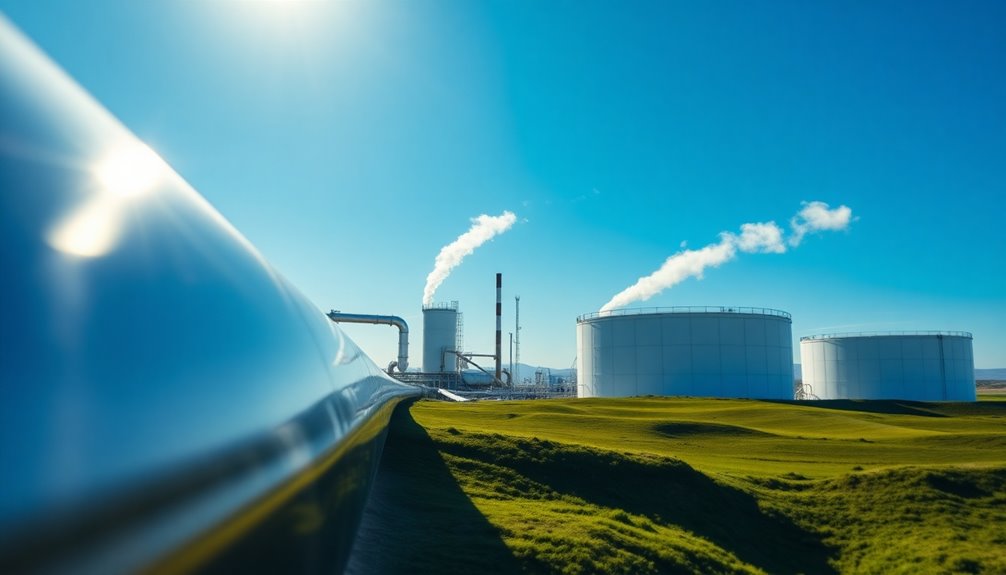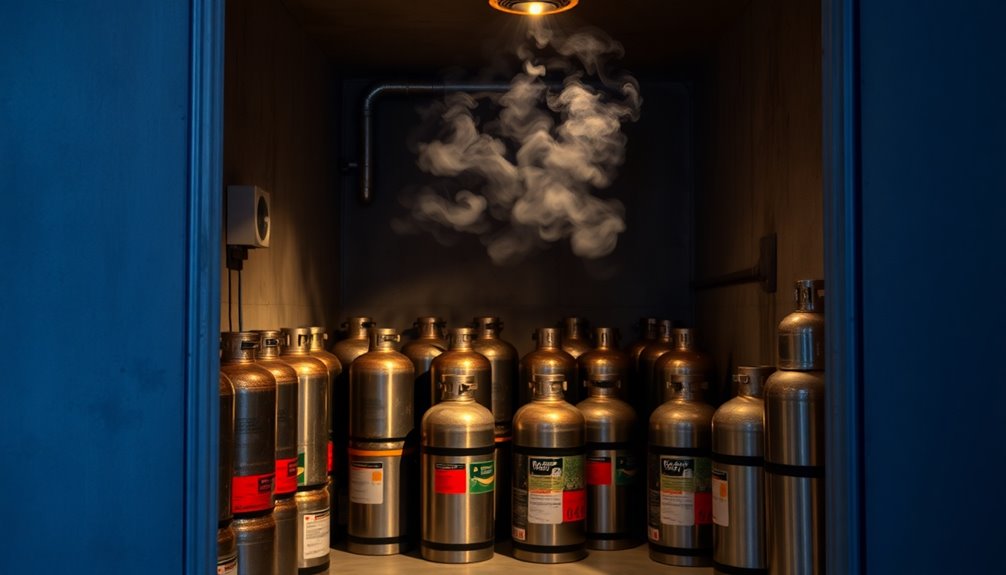Gas is a state of matter without a definite shape or volume. It fills any container you place it in, and its molecules move quickly due to weak intermolecular forces. Common gases include oxygen and nitrogen in the air, and natural gas, mainly comprised of methane, is a popular energy source. Gas can be affordable and clean-burning, but it also has safety risks, like flammability and toxic exposure. Understanding gas properties helps you safely use it in daily life and industry. Explore further to discover more about the advantages, disadvantages, and safe handling of gas.
Key Takeaways
- Gas is a state of matter with no definite shape or volume, consisting of molecules that move rapidly and have high kinetic energy.
- Common gases in the atmosphere include nitrogen, oxygen, argon, and carbon dioxide, while natural gas primarily consists of methane.
- Gases can be compressed and expand to fill their containers, following principles like Boyle's Law and Charles' Law.
- Natural gas is an affordable energy source that produces lower carbon emissions compared to coal and oil.
- Safety measures are essential when handling gases due to flammability, toxicity, and the potential for leaks in confined spaces.
Gas Composition Overview

When you breathe in, you're taking in a complex mixture of gases that make up the air around us. This air is primarily nitrogen (78.1%) and oxygen (20.9%), with smaller amounts of argon (0.9%) and carbon dioxide (0.03%). Standard dry air composition provides a consistent reference for understanding these gases.
Other trace gases, like neon and methane, are present in even smaller quantities. In contrast, natural gas is predominantly methane (94.6%), but it also contains ethane, propane, and trace amounts of butane. The composition of natural gas can vary based on its source, showing different percentages of these components.
Understanding these gas compositions helps in various applications, from energy production to environmental assessments, and it highlights the importance of standard definitions for accurate measurements and contracts.
Understanding Gas Properties

Understanding gas properties is essential for grasping how gases behave in various conditions. Gases lack a definite volume or shape, filling any available space. Their molecules move at high velocities, exhibiting significant kinetic energy due to weak intermolecular forces.
As a result, gases have low densities and large intermolecular spaces, allowing for easy mixing and diffusion. When pressure increases or temperature decreases, gases compress; conversely, they expand under reduced pressure or increased temperature. The compressibility of gases allows for significant volume reduction when subjected to increased pressure conditions.
You can observe the relationships between pressure and volume through Boyle's Law and between temperature and volume via Charles' Law. These properties help you predict how gases will act in different scenarios, making them fundamental to understanding gas behavior.
Gas Behavior in Various Conditions

Gas behavior varies significantly under different conditions, influenced by factors like pressure, volume, and temperature.
According to Boyle's Law, if you decrease a gas's volume while keeping the temperature constant, its pressure increases.
Charles's Law tells you that at constant pressure, raising the temperature causes the volume to expand.
Meanwhile, Gay-Lussac's Law shows that if you keep the volume steady, increasing the temperature raises the pressure.
Together, these principles form the Ideal Gas Law, which connects pressure, volume, temperature, and the number of gas moles.
While this law helps predict gas behavior, it doesn't account for particle volume or intermolecular forces, which is where the Van der Waals equation comes in, providing a more accurate model for real gases. Understanding gas laws is essential for applications in engineering and technology.
Pros and Cons of Gas

While many appreciate the benefits of natural gas, it's essential to weigh its pros and cons carefully.
On the positive side, natural gas is affordable, often costing less than electricity and saving households around $900 annually. It's also environmentally friendlier than coal and oil, producing lower carbon emissions and improving air quality. Additionally, its reliability as a domestic energy source supports jobs and enhances national security. Furthermore, switching to natural gas can lead to potential savings of over $5,700 on average over 15 years.
However, natural gas has drawbacks. Its extraction can lead to methane leaks and environmental harm, and it's a non-renewable resource, raising sustainability concerns. Moreover, reliance on natural gas might stall the transition to fully renewable energy sources.
Balancing these factors is crucial for informed energy choices.
Gas vs. Liquid Properties

Gas molecules are widely separated, resulting in low density and high compressibility, while liquid molecules are closely packed, leading to higher density and lower compressibility.
Gases expand to fill their containers and have no definite shape or volume, while liquids maintain a definite volume and take the shape of their containers.
Kinetic energy in gases allows for free movement, whereas in liquids, molecules move past each other, enabling flow.
The strong intermolecular forces in liquids create a more stable structure compared to the weak forces in gases, affecting their thermal and flow characteristics.
Understanding these differences is crucial for effective utilization in various applications. Additionally, the balance between kinetic energy and intermolecular forces plays a critical role in determining the state of matter.
Safety Hazards in Gas Handling

When handling gases, it's crucial to recognize the various safety hazards that can arise. Flammable and oxidizing gases can ignite fires from flames or even static electricity. High temperatures may wear down gas cylinders, increasing fire risks. Regular inspections are vital for maintaining cylinder integrity, as physical damage, like drops or cracks, can lead to ruptures, causing severe injuries. Toxic gases pose health threats, causing symptoms like headaches and respiratory issues, especially in confined spaces. Additionally, gas cylinders can inflict physical injuries due to their weight, and high-pressure releases can be dangerous. Wearing proper PPE, like safety glasses and gloves, is essential to protect yourself from these hazards.
Emerging Gas Technologies

As the demand for cleaner energy sources grows, emerging gas technologies are stepping up to address environmental concerns and improve efficiency in gas handling and processing.
For instance, oxygen removal systems enhance natural gas quality by eliminating oxygen, making it more suitable for transport and feedstock.
Condensate recovery systems capture valuable liquids, reducing flaring and boosting processing efficiency.
Leak detection and repair programs are crucial for minimizing methane emissions, while vapor recovery units cut down on harmful volatile organic compounds. Air quality is significantly improved through the implementation of these technologies.
Technologies like Gas to Liquids (GTL) convert natural gas into high-quality liquid products, facilitating economic transport.
Compressed Natural Gas (CNG) and Liquefied Natural Gas (LNG) technologies further streamline the distribution and storage of natural gas, meeting global energy demands efficiently.
Proper Ventilation During Storage

Emerging gas technologies enhance efficiency and safety, but proper ventilation during storage remains vital for preventing hazardous situations. You need to ensure that storage areas are well-ventilated to avoid gas accumulation in case of leaks. Always store compressed gas cylinders in cool, dry spaces, away from heat sources and open flames. Maintain ventilation rates as per safety manuals like the ESH Manual Chapter 13.2. Keep cylinders at least 20 feet from flammable materials and ensure toxic gas cylinders are in separate, well-ventilated areas. Additionally, understanding the common hazards associated with compressed gases is crucial for implementing effective safety measures. Store full and empty cylinders separately, and avoid obstructing exits or corridors.
Frequently Asked Questions
What Are the Common Uses of Gas in Everyday Life?
You'll find gas plays a vital role in your everyday life.
It's commonly used for heating your home and water, with around 60% of U.S. households relying on it for efficiency.
In cooking, gas stoves offer quick heat.
Additionally, gas fuels vehicles and municipal transport, while also being essential for manufacturing everyday products like plastics and electronics.
Its presence in industrial processes highlights its importance in producing goods you use daily.
How Does Gas Impact the Environment?
Gas impacts the environment in various ways. It emits fewer pollutants than coal and oil, improving air quality.
However, extraction processes can harm wildlife and local ecosystems, leading to habitat destruction.
While burning gas produces carbon dioxide, methane leaks during production are significant contributors to greenhouse gas emissions.
You face a complex balance between the benefits of cleaner energy and the environmental drawbacks of extraction methods affecting the planet's health.
Can Gas Be Converted to Other Forms of Energy?
Yes, gas can definitely be converted to other forms of energy.
You can utilize natural gas for various processes like converting it into hydrogen through steam methane reforming.
Additionally, you can transform it into liquid fuels like diesel and gasoline using the Gas-to-Liquid process.
Moreover, gas can generate electricity via gas turbines, enhancing efficiency and reducing emissions.
Each method showcases the versatility of gas in meeting different energy needs effectively.
What Are the Economic Implications of Gas Prices?
When the rubber meets the road, gas prices affect everything. You feel the pinch as higher prices drain your disposable income, making you more cautious about spending on groceries, dining, and leisure.
Businesses face similar struggles, raising prices or cutting costs to cope. This ripple effect can slow economic growth and dampen consumer confidence, leading to a cycle of reduced spending and cautious hiring, ultimately impacting the broader economy.
How Is Gas Transported Over Long Distances?
When you're looking at how gas is transported over long distances, pipelines are your primary method.
These extensive networks, spanning about 3 million miles in the U.S., connect production areas to consumers. Compressor stations maintain pressure for smooth flow, while liquefied natural gas (LNG) offers a more efficient option for maritime transport.
Conclusion
In understanding gas, you gain insight into its composition, properties, and behavior. You recognize the pros and cons, appreciate the differences between gas and liquid, and become aware of safety hazards. You embrace emerging technologies and emphasize the importance of proper ventilation. By exploring these facets, you equip yourself with knowledge that enhances safety and efficiency in gas handling. So, whether you're working with it or just curious, you're now better prepared to navigate the world of gas.









